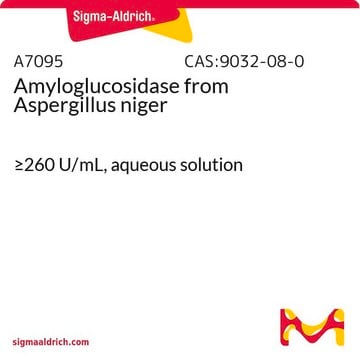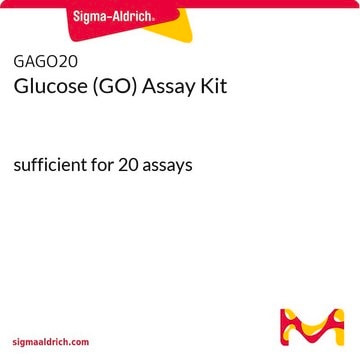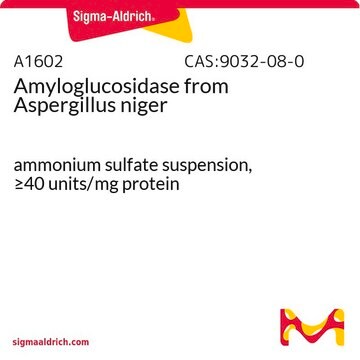ROAMYGL
Roche
Amyloglucosidase
from Aspergillus niger
Synonym(s):
Glucoamylase, disaccharidase-type-α-D-glucosidase
Sign Into View Organizational & Contract Pricing
All Photos(1)
About This Item
Recommended Products
biological source
Aspergillus niger
Quality Level
form
suspension
specific activity
~14 units/mg protein (At 25 °C with glycogen as the substrate; standardized with BSA.)
mol wt
Mr 97 kDa
packaging
pkg of 10 mL (10102857001 [100 mg])
manufacturer/tradename
Roche
parameter
55 °C optimum reaction temp.
optimum pH
4.6-4.8
storage temp.
2-8°C
Related Categories
General description
Amyloglucosidase is synthesized by several Aspergillus genus species. It is a disaccharidase–type α-glucosidase. This enzyme is an exo-enzyme and one of the major industrial enzymes. The stability of amyloglucosidase can be increased by immobilization.
Specificity
Cleaves terminal glucoses that are α1,4- or α1,6-linked to an oligo- or polysaccharide of multiple glucose units. The product is D-glucose.
Heat inactivation: Heat inactivation is recommended at 80 °C for 45 minutes, followed by rapidly cooling down.
Heat inactivation: Heat inactivation is recommended at 80 °C for 45 minutes, followed by rapidly cooling down.
Application
Amyloglucosidase from Aspergillus niger can be used for the hydrolyzation of terminal α1,4- and α1,6-glucosidic bonds (glucose-glucose bonds) in polysaccharides (e.g., starch, dextrins, glycogen), removing glucose units sequentially from the non-reducing end of the molecule. The enzyme will also cleave maltose and maltosides (maltotriose, maltotetraose, etc.).
Biochem/physiol Actions
Amyloglucosidase from Aspergillus niger is capable of hydrolyzing the α-D-(1-4), the α-D-(1-6), and the α-D-(1-3) glucosidic bonds of oligosaccharides. Amyloglucosidase is an extracellular enzyme that converts starch to dextrins and glucose. The enzyme is used in the starch-processing industry for the commercial production of D-glucose from corn syrups.
Unit Definition
Unit Conversion: One unit (+25 °C; glycogen as substrate) corresponds to 8.6 U (+60 °C; starch as substrate).
Physical form
Suspension in 3.2 M ammonium sulfate solution, pH approximately 6
Other Notes
For life science research only. Not for use in diagnostic procedures.
Storage Class Code
12 - Non Combustible Liquids
WGK
WGK 1
Flash Point(F)
does not flash
Flash Point(C)
does not flash
Choose from one of the most recent versions:
Already Own This Product?
Find documentation for the products that you have recently purchased in the Document Library.
Customers Also Viewed
High-potency amyloglucosidase-producing mold of the Aspergillus niger group.
Smiley KL, et al.
Applied Microbiology, 12(5), 455-455 (1964)
Recent Advances in Basic and Applied Aspects of Industrial Catalysis (1998)
A A Amirul et al.
Folia microbiologica, 41(2), 165-174 (1996-01-01)
A. niger produced alpha-glucosidase, alpha-amylase and two forms of glucoamylase when grown in a liquid medium containing raw tapioca starch as the carbon source. The glucoamylases, which formed the dominant components of amylolytic activity manifested by the organism, were purified
Guang W Wong et al.
Proceedings of the National Academy of Sciences of the United States of America, 101(28), 10302-10307 (2004-07-03)
Biochemical, genetic, and animal studies in recent years have established a critical role for the adipokine Acrp30/adiponectin in controlling whole-body metabolism, particularly by enhancing insulin sensitivity in muscle and liver, and by increasing fatty acid oxidation in muscle. We describe
TOR acts as a metabolic gatekeeper for auxin-dependent lateral root initiation in Arabidopsis thaliana.
Stitz, et al.
The Embo Journal, 42, e111273-e111273 (2023)
Our team of scientists has experience in all areas of research including Life Science, Material Science, Chemical Synthesis, Chromatography, Analytical and many others.
Contact Technical Service









